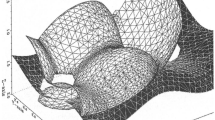Abstract
Currently, the selection of receiving traces in geometry design is mostly based on the horizontal layered medium hypothesis, which is unable to meet survey requirements in a complex area. This paper estimates the optimal number of receiving traces in field geometry using a numerical simulation based on a field test conducted in previous research (Zhu et al., 2011). A mathematical model is established for total energy and average efficiency energy using fixed trace spacing and optimal receiving traces are estimated. Seismic data acquired in a complex work area are used to verify the correctness of the proposed method. Results of model data calculations and actual data processing show that results are in agreement. This indicates that the proposed method is reasonable, correct, sufficiently scientific, and can be regarded as a novel method for use in seismic geometry design in complex geological regions.
Similar content being viewed by others
References
Bai, J., Peng, D. L., and Cai, X. W., 2010, Analysis of acquisition geometry based on ray tracing forward illumination: Progress in Exploration Geophysics (in Chinese), 33(2), 87–92.
Bruce, J. V., and Dechun, L., 2007, Modeling the impact of wide-azimuth acquisition on subsalt imaging: Geophysics, 72(5), 241–250.
Gerard, B., and Allan, A. R., 2007, Field design and operation of a novel deepwater, wide-azimuth node seismic survey: The Leading Edge, 26(4), 494–503.
Kjetil, E. H., and Martin, L., 2015, Variable source depth acquisition for improved marine broadband seismic data: Geophysics, 80(3), 69–73.
Nick, M., Jerry, K., and Mark, E., 2008, Full-azimuth imaging using circular geometry acquisition: The Leading Edge, 27(7), 908–913.
Qian, G. P., Kang, J. G., and Wang, Z. J., 2001, Modelbased seismic acquisition parameter analysis: Computing Techniques for Geophysical and Geochemical Exploration (in Chinese), 23(2), 109–112.
Rajiv, K., Haneet, W., and Felix, J. H., 2015, Source separation for simultaneous towed-streamer marine acquisition —A compressed sensing approach: Geophysics, 80(6), 73–88.
Timothy, D. J., Christian, D., and Rakib, H., 2015, The coherency of ambient seismic noise recorded during land survey sand the resulting implications for the effectiveness of geophone arrays: Geophysics, 80(3), 1–10.
Wen, S. L., Yin, C., and Li, X. X., 2011, Seismic illumination method and its application in seismic geometry design in deep waters: Oil Geophysical Prospecting (in Chinese), 46(4), 506–512.
Zhao, D. D., Guo, J., Wang, X. B., et al., 2006, Optimal design of model-based and object-oriented Geometry: West China Petroleum Geosciences (in Chinese), 2(2), 119–122.
Zhao, H., Yin, C., and Li, R., 2011, Research on the offset design method based on maximal efficiency of geophone received illumination energy: Oil Geophysical Prospecting (in Chinese), 46(3), 333–338.
Zhu, J. P., Dong, L. G., and Cheng, J. B., 2011, Targetoriented 3D seismic optimal geometry design based on seismic illumination: Oil Geophysical Prospecting (in Chinese), 46(3), 339–348.
Acknowledgments
The author is grateful to Liu Zhen-dong, senior engineer, and Cai Xi-ling, general engineer, for their suggestions which considerably helped to improve this paper.
Author information
Authors and Affiliations
Corresponding author
Additional information
This work was supported by the National Natural Science Foundation of China (No. 41304115), National Key S&T Special Projects (No. 2016ZX050 24001-003), Open Fund for Sichuan Province Key Laboratory of Natural Gas Geology (No. 2015trqdz02), and the Research Project, CNPC (No. 2016A-33), “Young and Middle-aged Key Teachers” Training Program in Southwest Petroleum University.
Zhao Hu, associate professor, received his PHD at the Chengdu University of Technology and teaches at the School of Geoscience and Technology of Southwest Petroleum University (SWPU). He mainly researches methods of gathering seismic data and seismic reservoir prediction technology for complex areas. He has successively worked with the National Natural Science and Technology fund, and participated in the National Key Basic Research Program (973), the National Key S&T Special Projects, and Provincial Science and Technology Research projects.
Rights and permissions
About this article
Cite this article
Zhao, H., Wu, SH., Yang, J. et al. Designing optimal number of receiving traces based on simulation model. Appl. Geophys. 14, 49–55 (2017). https://doi.org/10.1007/s11770-017-0603-3
Received:
Revised:
Published:
Issue Date:
DOI: https://doi.org/10.1007/s11770-017-0603-3



